You can listen to Hoosier History Live! live on the air each Saturday, or listen online at the WICR website during the broadcast on any computer with speakers, anywhere, or on a smartphone. We invite you to visit our website!
May 28 show
Home-front life during the Civil War
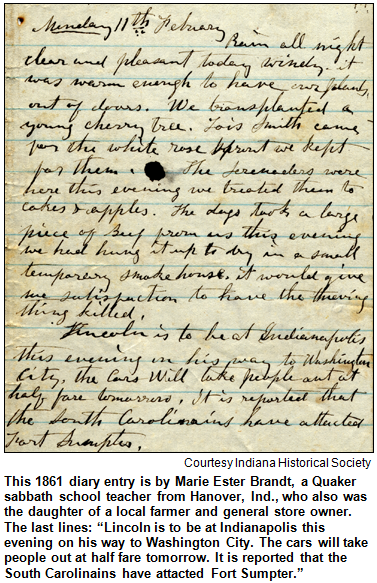 As the country marks the 150th anniversary of the start of the Civil War, it's worth noting that more than 200,000 men and teenage boys from Indiana fought for the Union cause. In fact, almost 75 percent of Hoosier men of military age served in the Civil War. That means Indiana ranked second only to Delaware in the percentage of men who served.
As the country marks the 150th anniversary of the start of the Civil War, it's worth noting that more than 200,000 men and teenage boys from Indiana fought for the Union cause. In fact, almost 75 percent of Hoosier men of military age served in the Civil War. That means Indiana ranked second only to Delaware in the percentage of men who served.
With thousands of husbands, fathers and oldest sons off to battle, what was the impact on the Hoosier home front? How did wives and young children cope with physically demanding farm work? What about families in towns where the absent patriarchs ran general stores, banks and taverns?
And, with the absence from Indiana of so many supporters of the Union cause, did Confederate-sympathizing Hoosiers who stayed behind - so-called "Copperheads" and "Butternuts" - take advantage of the situation?
Hoosier History Live! will explore these and other compelling questions as Nelson is joined in studio by two distinguished guests from Conner Prairie Interactive History Park, which is opening a $4.3 million Civil War exhibit in June. The new exhibit will feature "immersion experiences" of various aspects of the Civil War, including opportunities for Conner Prairie visitors to take on the roles of civilian volunteers who helped defend the Hoosier state from a raid by Confederate Gen. John Hunt Morgan and his forces. You can see a Conner Prairie preview video about the Morgan's Raid re-enactment.
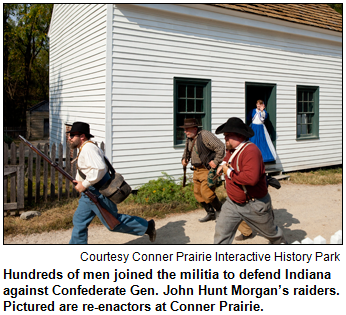 To explore the impact of the war (1861-65) on the home front's daily life, Tim Crumrin and Jim Willaert of Conner Prairie will join Nelson. They will share insights about everything from how rural families harvested crops and tended to farm animals (during an era when basic household chores alone, including cooking and doing laundry, could be all-consuming) to the impact on the schooling of children who undertook significant new responsibilities.
To explore the impact of the war (1861-65) on the home front's daily life, Tim Crumrin and Jim Willaert of Conner Prairie will join Nelson. They will share insights about everything from how rural families harvested crops and tended to farm animals (during an era when basic household chores alone, including cooking and doing laundry, could be all-consuming) to the impact on the schooling of children who undertook significant new responsibilities.
Tim, a senior historian who is Conner Prairie's experience delivery director, also will share insights about the demand for Hoosier agricultural products during the war. (He was the writer-director of Harvesting the Past, a PBS documentary focusing on Indiana's rural history.) The Civil War also increased the demand for Hoosier products such as wagons manufactured by the Studebaker Brothers of South Bend.
Jim, our other studio guest (and Conner Prairie's general manager of guest experience), is no stranger to Hoosier History Live! In previous appearances, he has shared insights about how early settlers and Native Americans survived harsh Indiana winters; he also has discussed the history of White River.
During this week's show, Tim and Jim will join Nelson in exploring how Hoosier families received pay from soldiers fighting in the Union Army. Furloughs for soldiers, Tim says, were far more extensive during the Civil War than many people realize.
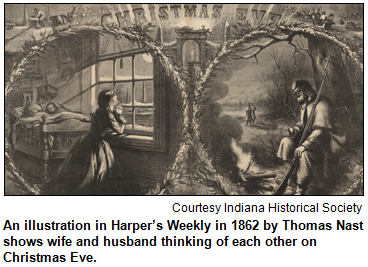 He also will discuss the sporadic "Butternut raids" across Indiana in which Confederate sympathizers harassed recruitment agents for the Union Army. Decades after the Civil War, experts concluded reports of Copperheads in Indiana that prevailed at the time were exaggerated.
He also will discuss the sporadic "Butternut raids" across Indiana in which Confederate sympathizers harassed recruitment agents for the Union Army. Decades after the Civil War, experts concluded reports of Copperheads in Indiana that prevailed at the time were exaggerated.
"Still, the perception was reality to many Hoosiers, who kept an eye out for treason and disloyalty among the neighbors," Tim notes.
Suffice it to say the Civil War altered thousands of lives on the Hoosier home front. Recent immigrants often found work as farm laborers hired by wives who suddenly had become single parents. Neighbors and children often pitched in to help harvest the crops of soldiers' families in ways that mirrored "community barn raisings," Tim says.
Tune in for what's certain to be a memorable show as we examine one of the most significant eras in Indiana's evolution.
History Mystery question
The History Mystery is a carryover from our show two weeks ago, when there wasn't a correct answer. The question concerns a massive replica of a mythical character that was displayed in the late 1940s at Union Station in Indianapolis.  The replica of the folk character stood more than 50 feet tall, towered over the main concourse of the railroad station and was made of Styrofoam. Although the giant Styrofoam replica stood in Union Station for only a few seasons, it was such a hit that thousands of postcards bearing its likeness were distributed to travelers at the train station for several years.
The replica of the folk character stood more than 50 feet tall, towered over the main concourse of the railroad station and was made of Styrofoam. Although the giant Styrofoam replica stood in Union Station for only a few seasons, it was such a hit that thousands of postcards bearing its likeness were distributed to travelers at the train station for several years.
Question: What mythical character was replicated in giant Styrofoam form during the 1940s in Union Station? Hint: It was not Johnny Appleseed or Paul Bunyan, which were incorrect guesses from callers during our May 14 show.
To win the prize, you must call in with the correct answer during the live show. The call-in number is (317) 788-3314, and please do not call until you hear Nelson pose the question on the air. Please do not call if you have won a prize from any WICR show during the last two months. The prize is a Family Fourpack for admission to Conner Prairie, courtesy of our guests from Conner Prairie.
Roadtrip: Civil War-era surgery in Wabash
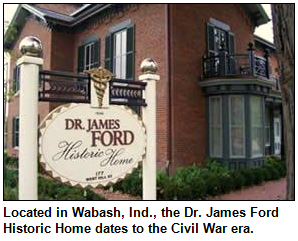 Chris Gahl of the ICVA suggests we take a Roadtrip to Wabash, Ind., to see an excellent example of what a Civil War era home and surgery might look like. The Dr. James Ford Historic Home includes period décor and the opportunity to experience the daily lives of Dr. James Ford and his family during the mid-1800s.
Chris Gahl of the ICVA suggests we take a Roadtrip to Wabash, Ind., to see an excellent example of what a Civil War era home and surgery might look like. The Dr. James Ford Historic Home includes period décor and the opportunity to experience the daily lives of Dr. James Ford and his family during the mid-1800s.
The home includes a Victorian-era flower garden and vegetable and medicinal herb gardens and is open to the public limited hours Wednesday through Sunday. There's more online at www.jamesfordmuseum.org.
A good time to head to Wabash would be June 23-26, when the Charley Creek Artsfest takes place!
Your Hoosier History Live! team,
Nelson Price, host and creative director
Molly Head, producer, (317) 927-9101
Chris Gahl, Roadtripper
Richard Sullivan, webmaster and tech director
Pam Fraizer, graphic designer
Garry Chilluffo, creative consultant
Michele Goodrich, Jed Duvall, grant consultants
www.hoosierhistorylive.org






Please tell our sponsors that you appreciate their support: Broad Ripple Brewpub, Heritage Photo and Research Services, Indiana Historical Society, Lucas Oil, Story Inn and The Society of Indiana Pioneers.
 Acknowledgments to Print Resources, Indianapolis Marion County Public Library, Monomedia, Indiana Humanities, Indianapolis Convention & Visitors Association, WICR-FM, Fraizer Designs, Chelsea Niccum and many other individuals and organizations. We are an independently produced program and are self-supporting through organizational sponsorships, grants and through individual tax-deductible contributions through the Indiana Humanities Council. Visit our website to learn how you can support us financially.
Acknowledgments to Print Resources, Indianapolis Marion County Public Library, Monomedia, Indiana Humanities, Indianapolis Convention & Visitors Association, WICR-FM, Fraizer Designs, Chelsea Niccum and many other individuals and organizations. We are an independently produced program and are self-supporting through organizational sponsorships, grants and through individual tax-deductible contributions through the Indiana Humanities Council. Visit our website to learn how you can support us financially.
June 4 show
Randy Carmichael on his dad, Hoagy
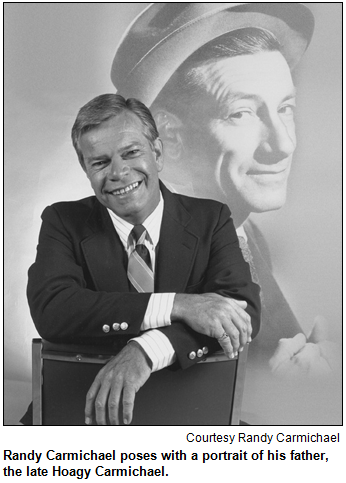 To the extent songs that become international standards make a composer immortal, Hoagy Carmichael, who grew up in Bloomington and Indianapolis, lives around the world whenever there's a gathering of jazz aficionados or lovers of music with a dreamy, almost surreal quality.
To the extent songs that become international standards make a composer immortal, Hoagy Carmichael, who grew up in Bloomington and Indianapolis, lives around the world whenever there's a gathering of jazz aficionados or lovers of music with a dreamy, almost surreal quality.
The list of Hoagy hits includes "Stardust," "Georgia On My Mind," "Up a Lazy River," "The Lamplighter's Serenade," "The Nearness of You" and even some Hoosier-specific tunes such as "Can't Get Indiana Off My Mind."
"It's people like Dad who, in my opinion, helped make Hoosiers feel comfortably at home in Indiana," Hoagy's youngest son, Randy Carmichael, told Nelson for his book Indiana Legends, which features Hoagy (1899-1981) among the assortment of famous Hoosiers on the cover.
An acclaimed pianist and vocalist, Randy Carmichael grew up in southern California while his dad was composing for movies and even acting in several, including classics such as To Have and Have Not (1944) and The Best Years of Our Lives (1946).
As a composer, Hoagy won the Academy Award in 1951 for "In the Cool, Cool, Cool of the Evening." About 20 years later, he was inducted into the Songwriters Hall of Fame.
Randy, who primarily has been based out of Florida in recent years, will share insights about his father just as plans are under way for a "Carmichael on Carmichael" concert in Wabash, Ind.  As a highlight of the Charley Creek Arts Fest that will feature an array of events June 23-26, Randy will perform during a dinner show June 25 in the ballroom of the Charley Creek Inn, the award-winning, recently restored historic hotel in Wabash. (For more information about the events, visit charleycreekartsfest.org.)
As a highlight of the Charley Creek Arts Fest that will feature an array of events June 23-26, Randy will perform during a dinner show June 25 in the ballroom of the Charley Creek Inn, the award-winning, recently restored historic hotel in Wabash. (For more information about the events, visit charleycreekartsfest.org.)
Some fun facts:
- In the 1910s, young Hoagy learned tips about how to improvise on the piano from
Reggie DuValle, a ragtime player in Indianapolis. (Regular listeners will recall the identity of Hoagy's mentor was a History Mystery question awhile back.)
- And when Hoagy still considered a career as a composer to be a pipe dream, he briefly worked as an attorney in several places, including Indianapolis and Bloomington.
© 2011 Hoosier History Live! All rights reserved.